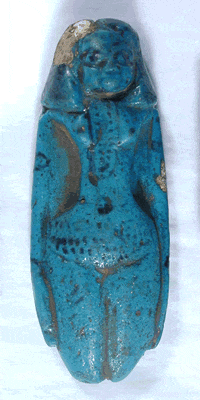Tattooing in Ancient Egypt
By Gemma Angel, on 19 November 2012
 by Gemma Angel
by Gemma Angel
Of all the objects on display in the Petrie Museum of Egyptology, there are two particular groups of items that immediately jumped out at me when I first began to look closely at the collections. These objects are grouped closely together in one of the densely packed cabinets towards the back of the gallery, near the sarcophagi – but no connection is explicitly made between them in the displays. This is not surprising, given that the first collection of objects – a series of tapered and sharpened metal implements – are described in the museum catalogue as “prick points” of indeterminate use:
Tool set identified as a “stock of seven prick points” for removing thorns, bronze; three bound together with thread, a fourth with thread round; three separate; cleaned and treated. No information on findplace within Madinat al-Ghurab; purpose and date uncertain.[1]

Seven “prick points” on display in the Petrie Museum,
possibly used for tattooing.
Image © UCL Museums & Collections
The prick points were excavated by Petrie at Gurob in 1880, alongside cosmetic items and fine pottery ware, which is suggestive of a cosmetic use. [2] When I first saw these objects, they brought to mind an article that I had read by Charlotte Booth, titled Possible Tattooing Instruments in the Petrie Museum. Booth carried out a close material analysis of the prick points, and found that they were made by folding the corners of a flat rectangle of bronze inwards at one end, and then beaten into a smooth finish. [3] Each of the 7 prick points were manufactured in this fashion. Interestingly, 3 of them are bound together with thread, which has become permanently fused to the surface by corrosion (pictured left: 3rd from right). Petrie believed that these objects were in fact tweezer points used for removing thorns:
Slips of bronze were made with long sharp points, and kept sometimes in a bunch of half a dozen; but they were not fastened to the tweezers. [4]
However, as Booth points out, although the points are very sharp, they do not appear to be fine enough for removing thorns from the skin. If they had served such an everyday purpose as Petrie suggested, then surely similar instruments would be more commonly found amongst toiletry objects in ancient tomb excavations? Could they perhaps have served a different, more specialised purpose?

A modern tattoo needle bundle, showing
a large number of fine needles in a
round arrangement, used for shading.
Needles may also be arranged in ‘flat’
or ‘magum’ formations.
To the eye of a tattooist, it is easy to see a resemblance between these ancient bronze points and modern tattoo needles, as they share a number of similarities: Tattoo needles are not hollow like hypodermic needles, as some people assume, but are actually solid. Groupings of very fine needles are bound together in a bundle, much like the Egyptian prick points, except that modern needles are soldered in place onto a stainless steel needle bar, rather than bound together with thread. Modern tattoo needles may be grouped in bundles of anything between 3 and 7 individual needles for line work, and as many as 14, 16 or 18 for shading and colouring. The needles operate by drawing ink up into the narrow spaces between them via capillary action as they’re repeatedly dipped into a small inkwell. This remarkably simple yet effective technology hasn’t changed in hundreds – perhaps thousands – of years. Writing on tattooing in Upper Egypt in the 1920’s, Winifred Blackman describes tattoo instruments consisting of 7 needles fixed to the end of a stick used by the Fellahin; [5] if these needles were indeed similar to those in the Petrie collection, this would suggest that the practice dates back at least 4,000 years in Egypt.

Blue faience figurine, decorated
to show hair, jewellery and tattoos.
Image © UCL Museums & Collections
Material evidence of ancient tattooing is extremely rare in the archaeological record, not least because of the difficulty in identifying artefacts and determining their original purpose. So what evidence is there that the ancient Egyptians practiced tattooing at all? The second group of objects which caught my attention at the Petrie museum provide some clues: two small blue faience figurines. Both of these objects depict nude female figures with black glazed decoration – one is broken at the waist, with only the lower portion of the torso preserved (object no. UC16724). The second figure is intact, with black detail indicating hair and what are assumed to be beads around her neck (object no. UC16725, pictured left).
Both figures are also decorated with a series of dotted lines across the abdomen, which are thought to represent tattoo markings. These markings bear striking similarity to tattoos found on ancient female mummies, which you can read more about in my next post on the Mummy of Amunet.
References:
[1] Petrie Museum online catalogue, object no. UC7790. See additional publications for more information on the origins of these objects.
[2] Charlotte Booth, ‘Possible Tattooing Instruments in the Petrie Museum’, in The Journal of Egyptian Archaeology, Vol. 87 (2001), p.172.
[3] Ibid, p.173.
[4] W.M.F. Petrie, Tools and Weapons, (London, 1917), pp.51-52.
[5] Winifred Blackman, The Fellahin of Upper Egypt, (London, 1927), pp.50-55.
[analytics-counter]
 Close
Close

